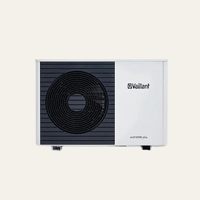The short version: heat pumps use clever but well understood science to move heat from the outside...
Should I Get a High Temperature Heat Pump?
The short version: while there are some situations where a high-temp unit is the tool for the job, for the majority of homes it's a more expensive option with fewer benefits than a standard unit.
With rising gas costs and the environment becoming an increasing concern, many homeowners are exploring alternative ways to heat their homes. Heat pumps are an increasingly popular option as they are far more energy efficient than traditional systems and create zero carbon emissions.
A development in recent years has been the introduction of high temperature heat pumps; units designed to heat water to a much higher temperature than standard heat pump units. While there are some cases where this is useful, for the vast majority of homes, a well-installed and properly sized standard air source heat pump is likely to be a better choice. Below we take a look at the key differences, and why a high temperature unit will generally not be necessary for UK homes.
A crash course in heat pump science
Before comparing the two types, it's helpful to understand how heat pumps work in general. Rather than generating heat through combustion like a boiler, heat pumps simply transfer heat from one place to another. An air source heat pump (ASHP) extracts heat energy from the outside air, concentrates it and transfers it inside for use in your home. In the UK, they typically do this by heating water that then flows through your pipes to your taps and radiators.
Because they just move heat around rather than generating it through combustion, heat pumps can be extremely efficient, with superior models generating over 4 units of heating for every 1 unit of electricity consumed. However, the higher the (water) temperature you are targeting relative to your heat source (e.g. the air), the harder the unit has to work and the less efficient it becomes. Make a mental note of this, because we’ll be coming back to this concept!
High temperature units are designed to heat to… higher temperatures!
When we talk about ‘high temperature’, what we are referring to is the temperature that they heat water to. A standard unit works best when heating to between 45°C and 55°C, high temperature models aim for between 65°C and 75°C. They achieve this through a combination of higher grade refrigerants and being more powerful (‘oversized’) units.
The intrinsic tradeoff between temperature and efficiency still remains, and so you can expect a high temperature unit to be 20% to 40% less efficient than a normal unit of similar specification (i.e. one using the latest refrigerant technology). For the homeowner, this means you can expect higher electricity consumption. To boot, high temperature models are typically £1,000 to £3,000 more expensive upfront than standard units of the same capacity.
High temperature is designed to solve specific problems
So why would anyone want a system that is less efficient and more expensive? The main benefit of high temperature systems is a simpler installation; they can be like-for-like replacements for most boilers and avoid having to make changes to radiators. This is because hotter water means you can heat the home with existing (i.e. smaller, older, less efficient) radiators. This can be useful if time is a factor (e.g. if your boiler has just broken mid-winter, as is so often the way) or if you live in a property where changes to radiators or plumbing is impractical (such as some listed buildings).
Be aware of the tradeoffs
So what’s the catch? While a quicker simpler install might sound good at first glance, let’s dig a little deeper. Your high temperature unit is more expensive to buy, likely wholly or partially offsetting any savings from not upgrading radiators. You are also forgoing the main benefit of a heat pump system - a highly efficient system for delivering a consistent, gentle heat - meaning higher bills and worse comfort. Furthermore, as high temperature units work harder to move that additional heat, you can expect higher noise levels and more maintenance.
Choosing what’s right for your home
So in most cases, homes (and the planet) are better served by a properly-sized standard air source heat pump with a reasonable safety buffer than an oversized high temperature unit. If you happen to have a strong preference for extra hot radiators, then the tradeoffs with a high-temperature system might be worthwhile for you. If you are in a listed property or have space constraints, then a high temperature unit might be your best option if you are keen to move away from gas.

Above: Modern, higher rated radiators (right) don’t necessarily take up more space.
You currently can get a one-time £7,500 grant towards a heat pump system, so it’s worth getting it right first time and choosing a system that will suit you for decades, rather than opting for a simpler install now and then paying for further changes in the future that won’t benefit from a grant.
Whatever you choose, get the right installer
Whichever your preference, the most important decision in your heat pump journey is choosing an experienced installer who can advise you well and design and install a system that fits your home. This means sizing the system for the home's heating load and setting the refrigerant and air flow rates correctly. An oversized or improperly installed standard heat pump can actually be less efficient than a properly installed high temperature model.
But given the higher upfront costs, reduced efficiency at typical UK winter temperatures, for most homes, investing in quality installation of a well-sized standard air source heat pump is the wise choice for maximizing efficiency and comfort.
Interested in learning more about what a heat pump could do for your home? Get in touch to arrange a free consultation with one of our heating experts.




